Sleep Wrinkle Prevention Checker
Your Sleep Wrinkle Risk Assessment
Recommended Pillow
Silk pillowcase
Reduces friction and pressureSleep Position Tip
Try back sleeping with a small pillow under knees
Reduces facial pressureEver wake up and notice fine lines staring back at you from the mirror? That’s not just an old myth-there’s a real link between the way you sleep and how your skin ages.
In this guide we’ll break down why sleep wrinkles form, what habits make them worse, and the practical steps you can take tonight to keep your face smooth for years to come.
What Are Sleep Lines?
Sleep lines are shallow creases that appear on the skin after a night of pressure or friction, most often on the cheeks, chin, and forehead. They differ from deep, permanent wrinkles because they’re primarily caused by mechanical stress during sleep, not just years of sun exposure. However, repeated stress can accelerate the breakdown of skin’s structural proteins and turn temporary lines into lasting marks.
How Sleep Affects Skin at a Molecular Level
While you’re snoozing, your skin isn’t on a total break. It continues to repair, produce collagen, and maintain moisture. Two key players determine whether that repair translates into firmer skin or extra lines:
- Collagen - the protein that gives skin its strength and bounce. Production peaks during deep sleep and drops sharply when sleep is fragmented.
- Skin elasticity - the ability of the dermis to snap back after being stretched. It relies on both collagen and elastin fibers, which need uninterrupted rest to stay resilient.
If you’re constantly pressing your face against a pillow, you’re essentially pulling on those fibers while the skin’s repair crew is trying to rebuild them. Over time the fibers lose their memory, and the temporary creases become permanent.
Top Sleep Habits That Trigger Wrinkles
- Side sleeping with the face pressed into the pillow. The most common culprit; pressure forces the skin to fold every night.
- Using thick, rough pillowcases. Cotton or linen that rubs against the skin can cause micro‑abrasions, especially on delicate facial skin.
- Sleeping with the mouth open. Mouth breathing dries the skin, reducing its ability to stay supple.
- Skipping nighttime moisturization. Dehydrated skin is less elastic and more prone to creasing.
- Late‑night screen exposure. Blue light disrupts melatonin, leading to lighter, less restorative sleep.
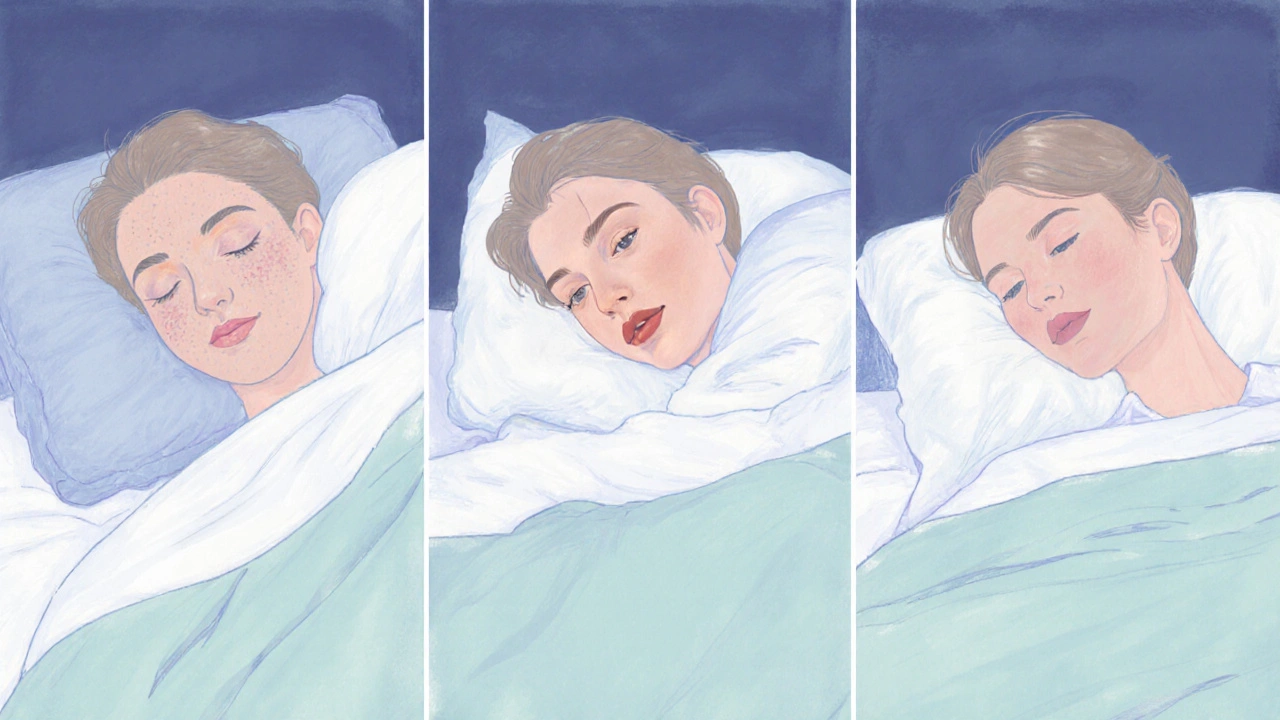
Choosing the Right Pillow for a Wrinkle‑Free Morning
Not all pillows are created equal. The right surface can reduce friction and pressure, giving your skin a chance to stay smooth.
| Material | Friction Level | Support for Side Sleepers | Best For |
|---|---|---|---|
| Silk‑woven pillowcase | Very low | Medium | Those who want the smoothest surface |
| Memory foam pillow | Low | High | Side sleepers needing firm support |
| Cotton sateen pillowcase | Medium | Medium | Budget‑friendly option |
| Latex pillow | Low | High | All‑night pressure relief |
For most people, a silk pillowcase is the easiest upgrade. It cuts friction dramatically, while a supportive memory foam pillow keeps the head from sinking too far, reducing the angle that forces the face into the fabric.
Optimizing Your Sleep Position
Changing habits is tougher than buying a new pillow, but a few tweaks can make a big difference.
- Back sleeping. This is the gold standard for wrinkle prevention because the face isn’t pressed against anything. If you’re not used to it, start by placing a small pillow under the knees to keep the spine aligned.
- Side sleeping with a pillow hug. Place a long, narrow pillow or a body pillow in front of you and rest your arm on it. This creates a barrier between your cheek and the pillow.
- Elevate the head slightly. A 2‑inch wedge can reduce facial swelling and keep fluid from pooling, which often makes lines more noticeable in the morning.
Remember, the goal isn’t to force a position you’re uncomfortable with. Small, consistent adjustments are more sustainable than overnight overhauls.
Nighttime Skincare Routine That Shields Against Sleep Lines
Even the best sleep setup can’t fully protect skin that’s dehydrated or lacking protective ingredients. Here’s a simple, evidence‑based routine:
- Cleanse gently. Use a sulfate‑free cleanser to remove makeup without stripping natural oils.
- Apply a hydrating serum. Look for ingredients like hyaluronic acid (Hyaluronic Acid) that lock in moisture and plump the skin.
- Layer a rich night cream. Products with peptides or retinol (Retinol) stimulate collagen while you sleep. Start with a low 0.3% concentration to avoid irritation.
- Seal it with a facial oil. A few drops of squalane or rosehip oil create a barrier that prevents friction with the pillow.
- Don’t forget the neck. The neck skin is thin and often overlooked, yet it shows early signs of aging. Apply the same products in upward strokes.
Consistency is key. The repair processes that happen during deep sleep need the right building blocks; otherwise, the skin can end up more vulnerable to mechanical stress.
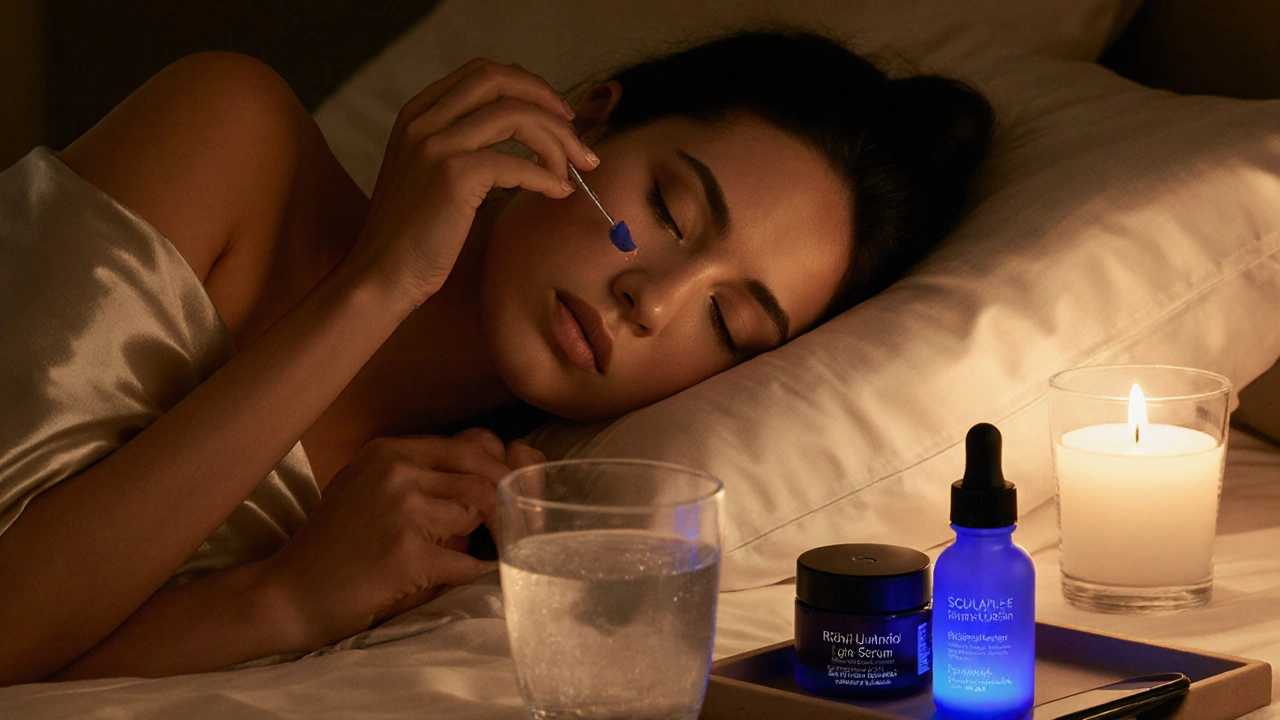
Lifestyle Factors That Amplify or Reduce Sleep‑Related Wrinkles
Beyond the bedroom, daily habits shape how quickly sleep lines become permanent.
- Hydration. Aim for at least 2 liters of water a day. Dehydrated skin loses elasticity faster.
- Nutrition. Antioxidant‑rich foods (berries, leafy greens) combat oxidative stress that weakens collagen.
- Sun protection. UV exposure degrades collagen by up to 30% over a decade. Even if you’re indoors at night, wear a broad‑spectrum SPF during the day to keep the skin’s matrix strong enough to resist sleep pressure.
- Stress management. Cortisol spikes can impair skin repair. Practices like meditation or gentle stretching before bed improve sleep depth.
- Avoid alcohol before bedtime. Alcohol fragments REM sleep, which is when a lot of collagen synthesis occurs.
Common Myths About Sleep Lines Debunked
Myth 1: “Sleep lines disappear on their own.” Minor creases often fade after a few hours, but repeated pressure causes micro‑tears that accumulate.
Myth 2: “Only older people get sleep wrinkles.” Even teenagers can develop temporary lines if they habitually sleep on one side with a rough pillowcase.
Myth 3: “Facial rollers erase sleep lines.” While rollers can boost circulation, they don’t address the root cause-mechanical pressure.
Putting It All Together: Your 7‑Night Action Plan
- Swap to a silk pillowcase and a supportive memory foam pillow.
- Start training yourself to sleep on your back for at least two nights a week.
- Add a hyaluronic acid serum to your nightly routine.
- Drink a glass of water before bed and keep a water bottle by your bedside.
- Turn off screens 30minutes before sleep; use a blue‑light filter if you must.
- Practice a 5‑minute breathing exercise to lower cortisol.
- Apply a light retinol cream (0.3%) three nights a week, increasing slowly.
Follow these steps consistently for a month and you’ll notice the morning “pillow creases” becoming less defined. Remember, prevention beats treatment-once a line sets in, it’s much harder to reverse.
Frequently Asked Questions
Do sleep lines become permanent wrinkles?
If the same pressure is applied night after night, the skin’s collagen can break down, turning temporary folds into lasting lines. Changing sleep habits early can stop that progression.
Is a silk pillowcase really worth the price?
Silk reduces friction dramatically compared to cotton or linen, which means less skin‑to‑fabric drag. Users typically report softer skin and fewer morning creases after a couple of weeks.
Can I still be a side sleeper and avoid sleep lines?
Yes. Use a body pillow or a long “hug” pillow as a barrier, and choose a low‑friction pillowcase. This keeps the cheek from pressing directly onto the pillow.
What ingredients should I look for in a night cream for wrinkle prevention?
Key ingredients include peptides (to signal collagen production), retinol (to speed up cell turnover), hyaluronic acid (for hydration), and antioxidants like vitamin C or niacinamide (to fight free‑radical damage).
How much sleep do I need for optimal skin repair?
Most dermatologists recommend 7-9hours of uninterrupted sleep. Deep, slow‑wave sleep, which peaks in the first half of the night, is when collagen synthesis is highest.



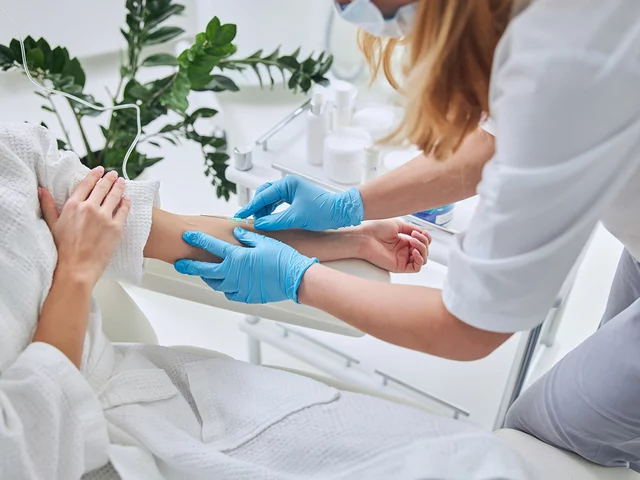


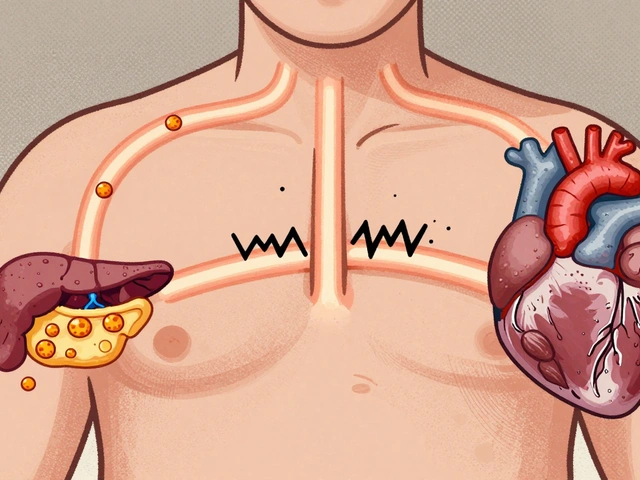
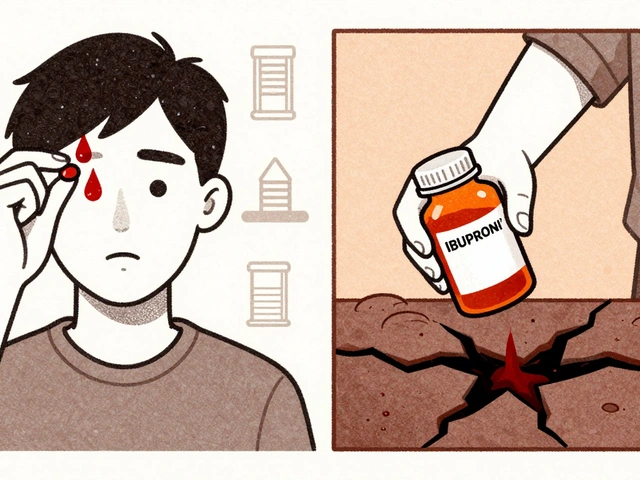
11 comments
Craig Mascarenhas
It is evident that the push for silk pillowcases serves a hidden agenda to increase consumer spending while claiming skin benefits.
aarsha jayan
Wow, the idea of turning your bedtime routine into a boutique spa experience is simply dazzling! 🌟 The silky smooth texture not only feels luxurious but also reduces friction that can lead to those pesky morning lines. Embracing a silk pillowcase can be a fun, self‑care ritual that empowers anyone to celebrate their skin.
Rita Joseph
When you combine a silk pillowcase with a consistent nighttime skincare routine-like a gentle cleanser, moisturizer, and occasional retinol-you’ll likely see a reduction in fine lines over time. The key is consistency; the skin repairs itself during deep sleep, and minimizing mechanical stress helps.
abhi sharma
Oh great, because my pillow wasn’t already judging me enough.
mas aly
I appreciate the practical tip about placing a small pillow under the knees; it helps keep the spine neutral and reduces facial pressure during back sleeping.
Abhishek Vora
Allow me to elucidate: the tensile forces exerted on the epidermis while we lie on a coarse cotton sheet are not trivial. Each night, countless micro‑abrasions accumulate, culminating in the formation of pronounced sleep lines. By opting for a silk or satin surface, you dramatically diminish shear stress, thereby preserving the dermal matrix.
maurice screti
In the grand tapestry of dermatological aesthetics, nocturnal mechanical trauma occupies a surprisingly prominent niche.
While the layperson may dismiss the notion that a pillowcase could influence cutaneous longevity, empirical evidence suggests otherwise.
The frictional interface between epidermal cells and a fibrous textile engenders micro‑tears that, over successive cycles, manifest as permanent furrows.
Moreover, the anisotropic tension applied during side or stomach sleeping exacerbates the propensity for collagen breakdown.
Silk, by virtue of its ultra‑smooth filamentous composition, offers a low‑coefficient surface that curtails shear.
This reduction in mechanical load permits the skin’s intrinsic repair mechanisms to operate unimpeded during the reparative phases of deep sleep.
Concurrently, the thermoregulatory properties of silk help maintain an optimal micro‑climate, preventing excessive perspiration that could otherwise predispose to bacterial colonisation.
It is also noteworthy that the incorporation of a modest pillow beneath the knees during supine repose alleviates lumbar lordosis, thereby indirectly diminishing facial compression.
When paired with a disciplined regimen of antioxidants and retinoids, the cumulative benefit can be substantial.
Nonetheless, one must remain vigilant against the over‑hyped commercial narratives that market silk as a panacea.
The material itself is not a substitute for adequate hydration, sun protection, or a balanced diet.
In a holistic paradigm, sleep ergonomics, topical interventions, and lifestyle choices converge to sculpt the visage of youth.
Therefore, the recommendation to adopt a silk pillowcase should be contextualised within a broader strategy aimed at preserving dermal integrity.
For those inclined toward evidence‑based practices, a simple experiment entails alternating nights with silk and cotton to observe differential skin texture over a month.
Ultimately, the pursuit of ageless skin is less about singular gimmicks and more about consistent, informed stewardship of one’s physiological environment.
Abigail Adams
It must be emphasized that the proliferation of “quick fix” solutions, such as merely swapping pillowcases, often obscures the fact that true dermal health is rooted in systemic factors, including nutrition, circadian rhythm integrity, and UV exposure mitigation.
Belle Koschier
Finding a middle ground between comfort and skin preservation is essential; a gentle pillowcase can complement other healthy habits without becoming an obsession.
Allison Song
One might contemplate the notion that our nightly rest is a microcosm of life's broader balance; where we align physical support with gentle care, we reflect an inner equilibrium that transcends mere aesthetics.
Joseph Bowman
Some folks claim the pillow industry is in cahoots with big beauty brands to push silk as the next must‑have, but honestly it’s just physics – less friction, less creasing.